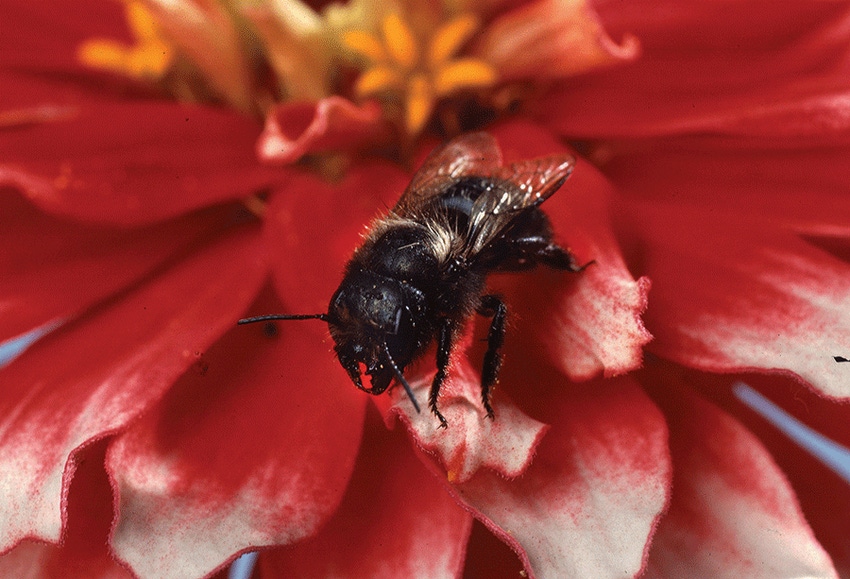
A native bee could someday play a pivotal role in helping honey bees with the increasingly daunting task of pollinating almonds, say industry and University of California researchers.
Early research suggests that integrating blue orchard bees, or BOBS, into orchards may improve pollination efficiency, reduce costs for farmers, and increase the reliability of production, the Almond Board of California reports on its website.
The USDA’s Agricultural Research Service describes the bees — Osmia lignaria — as efficient pollinators of fruit trees that are easy to manage and rarely sting. As almond acreage in California has expanded, in recent years scientists have grown more interested in using the bees to supplement honey bees because colony collapse disorder has decimated hives.
As the Almond Board explains, BOBs will venture out to collect pollen on days that barely reach the 50-degree mark, while honey bees are more likely to avoid such temperatures. Also, honey bees attach pollen to their back legs, so they tend to spread less of it than the BOBs, which collect it on their furry bodies.
CHALLENGES FOR RESEARCHERS
The challenge for researchers has been to figure out how to produce more of the tunnel-nesting bees and encourage them to stay where they’re needed. They don’t live in large hives, as honey bees do; rather, they make individual nests for their young in hollow plant stems and leftover beetle burrows in wood.
People have to gently coax the bees to nest closely together in boxes and build populations large enough to support crop pollination, the board notes. Some people are building or buying “bee condos,” blocks of wood drilled with specially-sized holes for nesting sites, according to the UC-Davis Department of Entomology and Nematology. Bees lay their eggs, provision the nests, and plug the holes, with offspring emerging months later.
Another issue with BOBs is that it takes an entire year — spring to spring — for the bees to reach adulthood, whereas worker honey bees require only 24 days to produce a flying adult, the Almond Board notes.
While honey bees originated in Europe and consist of one species, blue orchard bees are among about 1,500 species of native bees in California, including 450 in the Sacramento Valley, UC-Davis pollination expert Neal Williams says in presentations to producer groups. And while honey bees are social and live in hives, native bees are typically solitary.
Nearly a dozen native bees can pollinate almonds, including the bumble bee, the digger bee and the spring bee, he says. The more pollination that occurs, the better the nut yield and quality.
INCREASING INTEREST
The USDA Bee Biology and Systematics Laboratory at Logan, Utah has been gathering information about the blue orchard bee for nearly 50 years. There was more interest in the bee after it boosted cherry yields in Utah during a field trial from 1998 to 2003.
About a decade ago, the Almond Board teamed with the UC Integrated Pest Management Program to start observing the furry blue bees in Central Valley almond orchards.
Between 800 and 1,000 BOB females are needed to pollinate one acre of almonds effectively, Williams says. He suggests planting forage plants to feed the bees before and after almond bloom and to provide them with nesting resources. The cover crops would also provide forage for honey bees before almond bloom and improve their nutrition and health, he says.
When planting wildflowers, growers should be attentive to them and watch for weeds, which can be hand-pulled or controlled with grass-specific herbicides, he says. Remember that broadleaf herbicides will also harm wildflowers.
To view the Almond Board’s blog post about blue orchard bees, visit https://bit.ly/2JYOAfV
For the slide show of Williams’ presentation, visit https://bit.ly/2N7R1tF
About the Author(s)
You May Also Like






